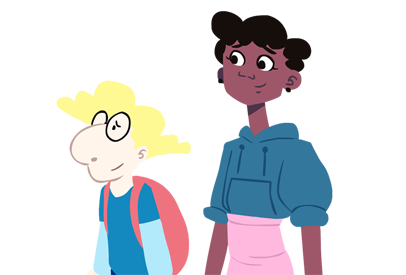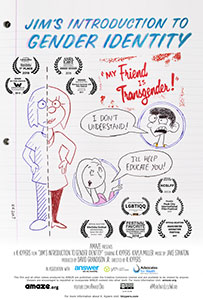This video explains what to do before, during, and after a yearly checkup with a doctor or health care provider. This is a health care visit you should have every year with your regular doctor or nurse practitioner, even if you’re feeling healthy. These visits are also called annual well visits. It’s great to talk to a parent or guardian before the visit and even have them in the room with you. It’s also okay to ask for time to talk to your health care provider one-on-one about important (and sometimes sensitive) questions you have about your health. That could include things you’re embarrassed to talk with your family about like mental health and sexual health. Many of these conversations will be kept confidential. [AMZ-178]
This video explores the topic of abortion. It provides information about medication and self-managed abortion, state laws and a person’s rights, and how and where a person can obtain more information. This video emphasizes the importance of the pregnant person’s right to determine their pregnancy options and how talking to a trusted adult can be helpful when trying to make the right choice. [AMZ-147]
This video explains how adolescents are able to access sexual health care and the different types of services that may be available to them. Also discussed is where youth can obtain sexual health, such as at a school-based health clinic, hospital, health department, or Planned Parenthood to name a few. Importantly, this video addresses a young person’s right to confidentiality and provides examples of the questions a person may want to ask their physician regarding the confidentiality of their care and treatment. [AMZ-102]
This video outlines proper active listening techniques such as eye contact, nodding, giving someone your undivided attention, asking questions, and making acknowledging statements. It also shows examples of good active listening, while offering suggestions for improvement such as restating the original concern or asking a clarifying question. The video also defines assertive communication and differentiates it from passive communication or aggressive communication. [AMZ-051]
This video explains the process of menstruation, or getting your period. It defines the endometrium, the length of a menstrual cycle, pads, tampons, and menstrual cups. The video also lists some ways to relieve cramps. [AMZ-016]
This video goes over the external and internal parts of biological female anatomy. It also defines the vulva, urethra, vagina, and anus, specifying the difference between the vulva and the vagina. The video defines ovaries and briefly explains the internal process of menstruation. [AMZ-070]
This video goes over the external and internal parts of biological male anatomy. It also defines an erection, semen, scrotum, testicles, and pre-ejaculate fluid (pre-cum). The video explains the difference between a circumsized and uncircumsized penis, how urine and semen travel through the urethra, and the inner workings of ejaculation. [AMZ-069]
This video defines bullying as well as the different types of bullying (physical, verbal, cyber). It also emphasizes that anyone can exhibit bullying behavior – bullies want to feel powerful, in control, and are generally unhappy. The video encourages young people to support those being bullied or tell a trusted adult. [AMZ-030]
This video talks about the signs and symptoms of pregnancy as well as where to get a pregnancy test. The video encourages youth who think they are pregnant to speak with a trusted adult and to see a health care provider. It then provides non-judgemental descriptions of the three pregnancy options: parenting, adoption, and abortion and affirms that the only person that can decide what option is best is the person who is pregnant. [AMZ-046]
This video acknowledges the awkwardness and excitement of learning about changing bodies, sexuality, gender, and reproductive organs. It encourages learning on your own with friends as well as with a parent/caregiver or trusted adult and cautions against relying solely on the internet, as there is a lot of misinformation. The video offers concrete advice on how to have awkward conversations with trusted adults. [AMZ-087]
Learn more about embracing your unique self and know that self-confidence is your greatest superpower. The most important thing that you can do is be yourself!
[AMZ-166]
Help kids learn how to be safe on the internet with this video. Our internet safety videos for students make being safe on the internet easy. [AMZ-033]
This video breaks down different short-term methods of contraception. It describes condoms and explains where to get them, that there are no age restrictions or prescription needed and that condoms are the only form of birth control that also lowers your risk of sexually transmitted diseases (STDs). The video also explains how to use a condom and to only use one condom for one act of sex. The video defines “The Pill” and explains that you can get The Pill through a prescription from your provider or a family planning clinic, and you should take it at the same time each day to prevent pregnancy. It also defines “the patch” and explains that you can get it through prescription and to change it once a week. Finally, the video emphasizes that you should use a condom and another form of birth control to effectively prevent pregnancy. [AMZ-020]
This video goes over the various ways to prevent pregnancy and STDs. It begins by stating the risk of pregnancy if one partner has a uterus and the other makes sperm, as well as the risk of spreading STDs if two people have sex and one person already has an STD. The video explains that some STDs can be cured, others need to be managed for life, and that using condoms can prevent both pregnancy and STDs. It also explains how “The Pill” can provide protection against pregnancy, but not STDs. The video also goes over Long Acting Reversible Contraception such as Depo Provera (“the shot”), intrauterine device, and the implant. It explains that you can get these methods from a doctor or a family planning clinic, and all are very effective in preventing pregnancy, but do not protect against STDs. The video suggests combining condoms with another method to more effectively prevent against pregnancy and STDs. It also defines abstinence as the only 100% effective way to avoid pregnancy and STDs and suggests talking to a caring adult, healthcare provider, or counselor. [AMZ-040]
This short video emphasizes that there are a range of different body types, skin color, and physical abilities. Instead of comparing yourself to others, you should focus on the positives about yourself. [AMZ-013]
This video explains that the pituitary gland releases hormones as you transition into puberty. It includes the definition of hormones, breast buds, and periods. The video goes over the physical changes of puberty, such as breast development, pubic hair growth, changes in hygiene, and acne. It advises young people to keep yourself clean, eat healthy, and work off excess stress with exercise to navigate puberty. [AMZ-002]
[AMZ-159]
This video encourages young people to support those being bullied or tell a trusted adult. [AMZ-110]
Starting in 2024, people in the United States began to notice an over-the-counter birth control option called Opill in pharmacies, grocery stores, gas stations, and online. Opill is an FDA-approved daily birth control pill, and just like ibuprofen, condoms, or emergency contraception, all ages and genders can buy it in stores or online without receiving a prescription from a doctor first. This video explores what exactly happens when you take Opill, why you don’t need to see a doctor first, and how it is different than other birth control pills. [AMZ-163]
This video explains that ending a relationship with a romantic partner can be an emotional experience for both partners, but it doesn’t mean you can’t decide to still be friends. [AMZ-131]
This video focuses on male gender role stereotypes and how they can limit boys’ experiences and expression. Featured in the video is an animated version of fencer Jason Rogers who intervenes in conversations where boys are feeling pressured to adhere to male gender role stereotypes. Jason shares how male gender stereotypes can prevent boys from expressing their true selves and experiencing a range of human emotions. The video encourages boys to be their best selves and not to feel limited by gender role stereotypes. [AMZ-111]
This video defines “coming out” and emphasizes that you get to make the choice of when and who you come out to, suggesting to make a plan for what to do if coming out does not go well, especially with your parents. The video also normalizes using different words to describe your sexual orientation at different times in your life. [AMZ-067]
This video discusses ways a person can talk to their partner about condoms; including the responsibility of protecting the health of you and your partner, the benefits of using condoms, and how to make a plan to get condoms. [AMZ-146]
This video describes condoms as an effective method to prevent pregnancy and STDs. It also provides tips on how to use condoms effectively, such as making sure the condom is not expired, how to put on a condom, use each condom only once, and how to dispose of the condom. The video also mentions the variety of sizes and colors of condoms, including condoms that come lubricated, and advises folks not to use vaseline or other oil-based lubricants, as that can break down the condom. It also mentions where condoms can be purchased and that there is no age limitation on purchasing condoms. [AMZ-052]
This video defines sexual consent and clarifies that just because someone agrees to one kind of behavior, doesn’t mean they want to engage in another. Everyone has the right to change their mind at any time, so you must always stop and respect the person’s wishes. It also clarifies that just because someone doesn’t say no, doesn’t mean they have given consent, and that the use of drugs and alcohol means that the person cannot give consent. The video also defines sexual assault and rape and emphasizes that if that is something youu experienced, it’s never your fault and you should consider talking to a trusted adult. [AMZ-017]
This video on consent and communication includes the definition of consent, including that the absence of “no” does not imply consent – verbal agreement is needed. It outlines what to do if someone touches you against your will, including telling the person to stop and/or telling a trusted adult. The video reinforces that you are not to blame if someone touches you without your permission. [AMZ-081]
Once you start to go through puberty, it’s possible to get pregnant or get someone pregnant, which is why it’s important to be familiar with different ways to prevent pregnancy. When people use birth control or contraception, they use a medicine, medical device or barrier like a condom to keep a sperm and an egg from uniting. Watch the full video to learn more!
[AMZ-107]
This video emphasizes the importance of young people having adults in their lives who can help them work through the challenges of growing up. It offers suggestions on how to have a conversation with an adult, such as figuring out what you want to say before you talk to an adult by writing it down or mentally preparing, making a list of people in your life that make you feel safe and listen to you, and being open and honest, even if it’s a little awkward. The video also clarifies that you can have different adults you talk to, since people have various insights to share. [AMZ-060]
This video discusses experiences of past sexual abuse. It explains what abuse is, and how it is never the fault of the person who experienced the abuse. It shows the importance of telling a trusted adult when you, or someone you know, has experienced abuse, harassment, or any behaviors that make you feel uncomfortable. Sexual assault, abuse, and harassment can happen to people of all genders and sexual orientations. This video includes conversations about the importance of reporting abuse and getting professional support. It is important to know that If the first adult you tell doesn’t believe you or doesn’t do anything to help protect you, keep telling other trusted adults until you get help. [AMZ-132]
This video states that every risk comes with a chance of rejection and emphasizes that while rejection can hurt, it’s a normal part of life. It highlights the best ways to deal with rejection, including accepting the decision of the person who rejects you, focusing on you instead of blaming yourself, taking a breath and talking to someone if you’re feeling angry or sad, thinking about your great qualities, and hanging out with friends. [AMZ-038]
Decoding dudes by debunking masculinity. Messages are often stereotypes that boys often grow up with and can stick with them until adulthood. [AMZ-161]
This video notes that feelings of hopelessness and sadness are normal, but if they persist longer than a week or two, this might be a sign of depression. It covers what to do if you feel this way, such as talk to a trusted adult. The video also defines anxiety disorders and its effects, suggesting talking to a trusted adult if youth are dealing with anxiety. [AMZ-066]
This video features definitions and examples of different kinds of families. It begins by defining the concept of family and the primary role to love and take care of each other, also stating that there is no right or wrong way a family should look. The video also defines a nuclear family, families with gay or lesbian parents, single parent families, extended families, blended families, families without children, adopted families, and foster parents. It emphasizes that families can be diverse, meaning parents or children can have different ethnicities or religious beliefs. It also defines chosen families, or families that are made up of friends and other supportive people rather than blood relatives. [AMZ-089]
This video on disability and sexuality states that people with disabilities have the same sexual and romantic feelings as anyone else, including a range of sexual orientations. It also reinforces the idea that people with disabilities want the same healthy relationships as anyone else, and they often have similar questions about relationships and their bodies. The video also goes over issues that people with disabilities are more likely to face, like overprotective parents, friends misunderstanding their disability, and trouble expressing feelings and consent verbally. [AMZ-079]
Online and in the media youth are constantly exposed to messaging that promotes the notion that bigger breasts mean better breasts, or that they make a person more attractive. This video sets out to debunk those messages. Breast size is a trait or feature that a person inherits from their parents, and breasts, just like our other body parts, come in lots of different shapes and sizes. [AMZ-094]
Messages from TV, movies and magazines might give the impression that having a bigger penis is better. This video sets out to debunk those messages. Penis size is a trait or feature that a person inherits from their parents, and penises, just like our other body parts, come in lots of different shapes and sizes. [AMZ-095]
This video introduces withdrawal, commonly referred to as “pulling out”, a method of contraception that people can use to prevent pregnancy when they do not have access to other more effective methods of birth control. The video also shares that withdrawal does not prevent STIs and therefore people who use this method of contraception should still get regularly tested for HIV and STDs. [AMZ-103]
Endometriosis, pronounced (en-doe-me-tree-O-sis), is a common, but serious and often painful condition of the reproductive organs. This video discusses the symptoms of Endometriosis, and encourages people who are concerned about endometriosis to talk to a medical provider and a trusted adult, like a parent or other family member. The video also dispels some common myths about Endometriosis, and explains why young people especially should seek medical care. [AMZ-148]
Express yourself, your way! Learn about the difference between gender identity and gender expression, and why it’s important to respect everyone. [AMZ-006]
This video discusses how puberty and hormones can affect a person’s mental health. It also gives the signs of depression and anxiety. The video explains who to talk to when you or someone you know might be experiencing depression, anxiety, or another mental health issue. The video encourages young people to reach out to a trusted adult and reminds them that they are not alone. [AMZ-056]
This video defines masturbation and reinforces that people of all genders masturbate. It emphasizes the normalcy of masturbation as a physically safe way to express sexual feelings. The video also debunks myths of negative effects of masturbation and suggests that if masturbation impacts normal daily routine that youth should talk to a trusted adult. [AMZ-086]
This video goes through the steps to conflict resolution, emphasizing that conflict resolution requires practice and effort from everyone involved. Steps to conflict resolution include:
- Determining what the disagreement is actually about
- Explaining how you feel and how the conflict is affecting you
- Listening to what the other person needs and trying to understand their point of view
- Brainstorming solutions that will make both people happy
- Sticking to what was decided, and If solution isn’t working, coming up with a new one
[AMZ-077]
This video encourages young people to find an adult that they’re able to talk to about navigating situations that may arise during adolescence. Some young people may find it helpful to talk to a relative, but others prefer to talk to a teacher, coach, or friend’s parent. The video acknowledges that some adults aren’t good listeners, don’t always believe young people, or tell young people what to think. The video advises young people to find an adult that respects them enough to listen without judgment and to test out whether an adult would be a good fit to talk to, such as if the young person has heard them give good advice to others. [AMZ-047]
Intimate partner violence (IPV), sometimes called teen dating violence or domestic violence, is when a person behaves in a way to control another person in an intimate relationship. This video defines intimate partner violence, discusses ways to get help from people at school, family members, or even the community, and shares the importance of trying to try and help someone you know by accessing resources and help to get out of an unsafe situation. [AMZ-152]
This video offers suggestions to a young person unsure if they are ready for their first kiss with a partner. It encourages you to ask yourself if you trust and feel comfortable with this person, confirm if you have their consent, and ask yourself why you want to do something physical with them to ensure you are not feeling pressured into affection. The video also encourages young people to think through what types of affection you’re comfortable with and discussing everything with your partner. It also emphasizes that it’s never okay to pressure anyone into kissing or any other behavior, and that it can be helpful to talk to a friend, sibling, or trusted adult. [AMZ-076]
During your menstrual cycle, you may experience a wide range of emotions and feelings and use various menstrual hygiene products. [AMZ-160]
This video includes a scenario of friends drifting apart. It highlights that sometimes friends fight, are interested in other things, or grow apart, but that doesn’t mean they don’t want to be together or they won’t find other friends. [AMZ-007]
This video focuses on gender role stereotypes, touching on the history of traditional gender roles for people born male or female. It goes over how gender role stereotypes affect ideas of beauty and how boys and girls can act according to these stereotypes. The video also explains how gender roles affect how people display emotions. Finally, it explains how expectations of gender roles have changed over time – now, more and more people are able to be true to who they are. [AMZ-072]
This video outlines tips for healthy friendships and relationships. These tips include:
- Each person supports and encourages each other
- Real friends want to know what you’re thinking and are interested in what you have to say
- It’s okay to have disagreements, but do so respectfully and talk openly with each other
- You will probably need to compromise, but the same person should not be the only one who compromises
- Treat your relationships with care
- Healthy relationships should make you feel good about yourself and who you are
[AMZ-028]
This video considers how HIV or human immunodeficiency virus can affect people’s bodies in the same ways, while affecting communities differently. HIV affects people’s bodies in the same way by attacking people’s immune systems and making it difficult for people to fight infections. Some communities have greater portions of their communities seriously affected by HIV. When some communities are more seriously burdened by a disease than other communities, this is called a health disparity. Read on to learn why health disparities exist. [AMZ-112]
HIV prevention, treatment, and care has come a long way, and what you thought you knew might not be true anymore. In this AMAZE compilation, we break down some of our most asked HIV questions from teens. Questions like: what does HIV do to the body? How does it spread? How can you prevent it? And what’s it like living with HIV today? [AMC-016]
This video defines Human Immunodeficiency Virus (HIV) and AIDS (acquired immunodeficiency virus) and explains the way HIV can weaken the body’s immune system to make a person vulnerable to other infections. It clarifies that HIV can only be spread through contact with bodily fluids, not casual contact. The video states that HIV is usually transmitted through sex, sharing needles, or from mother to child through breastmilk. It also goes over ways to protect yourself against HIV, including waiting to have anal, oral, or vaginal sex (or using condoms every time) and not injecting drugs. The video emphasizes getting tested regularly for HIV and other STDs, either at your doctor’s office, a family planning clinic, or using an at-home test. The video states that while there is no cure for HIV, there are drugs that help people with HIV live healthy lives, and a drug called PrEP that can help prevent HIV. [AMZ-044]
This video follows the story of ‘Newbie’ in their journey of learning how birth control pills work. The video takes places inside the uterus, as ‘Newbie’ gets a tour of the reproductive system and how it is affected by birth control pills. The video also dispels some common myths about birth control.
Once you start to go through puberty, it’s possible to get pregnant or get someone pregnant, which is why it’s important to be familiar with different ways to prevent pregnancy. When people use birth control, or contraception, they use a medicine, medical device or barrier like a condom to keep a sperm and an egg from uniting. Some birth control, like the Pill, the Patch and the Shot, are medicines that keep the ovary from releasing an egg or ovum. Other birth control methods help create a barrier at the opening of the cervix to keep sperm from getting inside the uterus to find an egg. Abstinence, or choosing to not have or delay having sex, is the most effective form of birth control. [AMZ-145]
This video explains the many different ways LGBT+ couples have babies! There are many ways people can have a family, such as adoption, raising step-children, fostering, artificial insemination, surrogacy or other options! [AMZ-096]
This video goes through the concept of erections (or boners). It emphasizes the normalcy during puberty of getting erections even when a person is not sexually aroused. [AMZ-001]
This video offers tips on how to be a good listener. It advises young people to pay attention when someone is talking to them rather than being distracted by their phone or things around them or thinking about what they’re going to say next. The video also states to not judge what someone tells you, show empathy, and don’t offer solutions to a problem unless asked. Other listening tips include asking questions (but not interrupting) and being responsive by nodding your head and reflecting back what someone says. [AMZ-039]
This video details how to support your LGBTQ+ friends and loved ones – also known as being an ally. It suggests letting your LGBT+ friends know that you’re there if they need to talk, standing up for someone if they are being bullied due to their sexual orientation or gender identity, and getting involved in LGBT+ organizations or causes, such as a GSA. [AMZ-062]
The video explains that feeling anxiety in certain situations is normal and that there are tools young people can use to help manage the anxiety. The three tools the video discusses are preparation, positive self talk, and reset/refocus. The characters in the video practice using the tools to navigate common scenarios young people face. The video also encourages young people who feel their anxiety all the time – not just situationally – to talk to a trusted adult or therapist. [AMZ-174]
This video begins with different examples of rejection and reinforces the idea that rejection is just one person’s opinion – it doesn’t mean that you are not good enough. The video also discusses how to deal with rejection, beginning with accepting the person’s opinion rather than trying to convince them otherwise. It encourages young people to acknowledge feelings of sadness and hurt, take time to process feelings, and talk to someone you trust to help work through them. Finally, the video states that it is important to remember that just because you were rejected once, that doesn’t mean you will always be rejected. [AMZ-065]
This video explores signs of an unhealthy relationship and the steps for leaving an unhealthy relationship. It shares the ‘how-to’’ of making a break-up plan, communicating with a partner, and seeking help from a trusted adult, if needed. [AMZ-144]
This video defines different communication styles, including passive, aggressive, and assertive. It also explains the disadvantages of passive communication, such as feeling like you’re being taken advantage of, and aggressive communication, such as getting your way but being disliked. The video emphasizes that assertive communication is the best style, as it involves communicating in a way that respects other people’s needs as well as your own. [AMZ-035]
This video features examples of different instances of peer pressure, such as when friends are stealing, smoking, and being intimate with a partner and they pressure you to do the same. It includes a definition of “peer” and “peer pressure” and emphasizes that decisions should be based on what you want, not your peers. [AMZ-025]
Having a family member or caregiver who is lesbian, gay, bisexual, transgender or queer (LGBTQ), may make you feel like you are different from other kids at school. What is important to remember is that every family is different. Some have two parents, some have only one, some have a mom and a dad and others have two moms or two dads. There are families with LGBTQ siblings and foster parents, or aunts, uncles, cousins and grandparents. There is no one right way to have a family. And while it may seem like you are different, being different is normal! [AMZ-109]
This video defines “intimate partner” and “intimate partner violence,” as well as types of intimate partner violence such as physical abuse, emotional abuse, and financial abuse. It also defines and gives examples of stalking/harassment and sexual abuse. The video covers where to seek help if you are experiencing intimate partner violence, such as a school counselor, social worker, or trusted adult. It also provides the National Domestic Violence hotline website and phone number. [AMZ-082]
This video defines romantic love and lists the ways people can show their love for someone, including hugging, kissing, doing nice things for them, telling them you love them. It also separates romantic love with sex and provides some physical signs of love such as sweaty palms, butterflies in your stomach, quickening pulse, and feeling nervous and/or excited. The video also gives examples of what happens when feelings of love are not mutual, or if a relationship is unhealthy. [AMZ-024]
This video defines Human Immunodeficiency Virus (HIV) and explains that HIV can weaken the body’s immune system. It goes over the different ways that HIV can be transmitted through bodily fluids (sex, needles, breastfeeding) or if someone who has HIV gives birth. The video also details the variety of feelings someone can experience when they are diagnosed with HIV and validates all reactions as normal. The video explains that while there is no cure for HIV, there are ways to take care of yourself so you can live a long healthy life with HIV. It also defines Antiretroviral Therapy (ART) as the medicine used to treat HIV. The video explains that there are laws and policies in place that ensure people living with HIV can participate in school activities, and people with HIV can still have sexual relationships as long as they take their medication and use condoms. The video also defines PrEP, a medication that can prevent HIV transmission for those at high risk. Finally, the video suggests that disclosing to others might help people living with HIV feel less alone, but should happen only when they are ready. Talking to a trusted adult if you have questions can help as well. [AMZ-080]
This video goes over the various Long Acting Reversible Contraception methods. It begins by defining contraception and Long Acting Reversible Contraception (LARC), then lists the different options for longer-lasting birth control. It explains Depo Provera ( or “the shot”), the implant (Nexplanon), and intrauterine device (IUD), including how each method works to prevent pregnancy and how to insert and remove each. The video states that while each LARC method is more than 99% effective against unwanted pregnancy, none provide protection against STDs, so it is important to also use a condom during sex. [AMZ-031]
This video emphasizes that you can feel free to be attracted to whoever you want to, encouraging young people to tell their friends or loved ones if they are struggling with keeping their sexual orientation a secret. It also lists different sexual orientations and includes the definition of bisexuality. [AMZ-012]
This video defines masturbation and emphasizes that it’s normal if you do it, normal if you don’t, and that it should always be done in private. It also debunks masturbation myths and suggests that if masturbation impacts normal daily routine, youth should talk to a trusted adult. The video states that masturbation is a normal, safe way to relieve sexual feelings. [AMZ-010]
This video features a song about consent, giving examples of situations where consent might be ambiguous. Situations include needing to ask someone something but they are asleep or unaware, wanting to do something but the person is not there to ask and last time they said yes, and being with the person but they are not saying anything. All of these situations are not consent. [AMZ-042]
Menopause signals the point in life when people who menstruate (or a person with a uterus) is no longer able to become pregnant and stops its monthly menstrual cycle permanently. This video explains the signs and symptoms of menopause, the three stages of menopause and the ages that a person may begin to experience menopause. [AMZ-149]
This video gives an overview of menstruation, or getting your period. It includes the internal process of menstruation, defines the endometrium, and introduces pads, tampons, and menstrual cups as ways to manage the blood flow of menstruation. The video also explains cramps and gives suggestions on how to manage pain. [AMZ-071]
This video discusses menstruation stigma, which is the discrimination that some people who menstruate (get a period) experience. The video includes the truth about periods and why common myths are incorrect. [AMZ-143]
This video defines menstruation and describes the biological process. It goes through the typical length of a period, light flow vs. heavy flow, and defines and lists the symptoms of Premenstrual Syndrome (PMS). The video mentions referring to periods in code such as “that time of the month.” It also goes over the reasons for menstrual cramps during periods and ways to relieve the pain. [AMZ-061]
This video defines money as a tool that helps people trade talents and services for the things they want and need. It explains the importance of knowing how to manage money while exploring how gender norms, which are rules and expectations about how a person should act based on their gender, can affect how people see, use and access money and so, impact their life choices. It talks about how unpaid tasks like taking care of smaller children, cooking, and cleaning, are valuable and need not be gender-specific activities and that anyone can aspire to get a paid job and manage their own finances. The video also shares tips about money such as prioritizing needs over wants, setting savings goals, creating a budget, and talking to parents about their first job experience. [AMZ-157]
This video defines transgender, which means that someone’s body does not match their gender identity. It clarifies that gender identity is not determined by genitals and defines the concepts of cisgender and gender identity. The video acknowledges that it can be scary to tell people that you are transgender if you don’t know how they’ll react and encourages acceptance of people who are transgender, even when you don’t understand. [AMZ-032]
This video uses a musical number to explain the concept of body odor (B.O). It also explains the difference between deodorant and antiperspirant and lists a few things you can do to prevent B.O. such as shower/bathe every day, wash and change clothes often, or use deodorant/antiperspirant. [AMZ-021]
This video describes how to use tampons, pads, and menstrual cups during your period. It goes over how each item works, when to replace, and what inserting or applying each item entails, such as touching your vagina when inserting a menstrual cup. [AMZ-057]
This video addresses different ways that people manage their menstrual flow or period. It explains what tampons, pads and menstrual cups are and how to use each of them. [AMZ-068]
This video explains the process of getting a period (menstruation), some common period symptoms and ways to manage them, and reviews disposable and reusable period products. [AMZ-139]
This video goes through the physical, emotional, and social changes of puberty for people with a vulva. It addresses common changes like hair growth, getting a period, mood swings, new sexual feelings and hygiene as young people are on their way to becoming an adult. [AMZ-140]
This video acknowledges how common it is for young people to stumble upon pornography or to seek it out because they are curious about sex. While young people’s curiosity is completely normal, this video makes it clear that pornography is not a good source of accurate information about sex. Pornography often features white actors with dramatically enhanced bodies, but in real life bodies come in a range of shapes, sizes, colors and abilities. Pornography also uses special effects, like those you might see in a superhero film, to have things happen that could never happen in real. Pornography can also feature sexual behaviors with no mention or use of safer sex or contraceptive methods. Pornography can also show people with vulvas having multiple orgasms over and over again, but this does not happen in real life. Scenarios in pornography also often include people engaging in sexual behaviors who have just met and don’t know one another. Most people find that sex feels better when they are in an intimate and caring relationship with a partner. [AMZ-116]
This video outlines some of the problematic elements of pornography, such as misleading messages around bigger breasts and penises as well as the duration of sex. Porn can also show women only existing to give men pleasure, might make it seem like being sexual with someone has nothing to do with having an intimate, trusting relationship with them, and could contain violent or disturbing images. The video also clarifies that being curious about watching people engage in sexual behaviors is normal, but to just be aware of some of these misleading messages. It encourages you to talk to a trusted adult if you see content that makes you feel uncomfortable. [AMZ-018]
This video breaks down the process of reproduction by explaining that if a fertilized egg attaches to the wall of a uterus, pregnancy has begun. It explains that typically sperm combines with an egg through vaginal sex, and semen is ejaculated and carries the sperm through the cervix and the uterus and into the fallopian tubes, where it meets the egg and implants on the uteran wall. The video also defines artificial insemination and in vitro fertilization. It also clarifies that pregnancy and childbirth are just one way a family can be formed – some people choose to adopt or not to have kids. [AMZ-045]
This video defines Human Immunodeficiency Virus (HIV) and AIDS (acquired immunodeficiency virus) and explains the way HIV can weaken the body’s immune system to make a person vulnerable to other infections. It clarifies that HIV can only be spread through contact with bodily fluids, not casual contact. The video states that HIV is usually transmitted through sex, sharing needles, or from mother to child through breastmilk. It also goes over ways to protect yourself against HIV, including waiting to have anal, oral, or vaginal sex (or using condoms every time) and not injecting drugs. The video emphasizes getting tested regularly for HIV and other STDs, either at your doctor’s office, a family planning clinic, or using an at-home test. The video states that while there is no cure for HIV, there are drugs that help people with HIV live healthy lives, and a drug called PrEP that can help prevent HIV. [AMZ-123]
This video features a scenario of a young person figuring out who they are in terms of style, clothes and crushes. It emphasizes being yourself rather than trying to be someone else. [AMZ-029]
There are a range of gender identities someone can identify as, which can be the same as or different from the sex assigned at birth. [AMZ-085]
This video includes a definition for rejection and lists the feelings that can come with it, such as sadness, anger, disappointment, and insecurity. It reinforces the idea that even if you are rejected, there’s nothing wrong with you or the person doing the rejecting.The video also states that rejection doesn’t mean you should stop doing the things you want to do and gives examples like not making the basketball team, friends not reacting well to a social media post, or asking someone out. Finally, the video explains how to deal with rejection: accept the rejection and acknowledge your feelings, talk to a trusted friend or adult if you are really feeling upset, and remember that these feelings are normal and won’t last forever. [AMZ-049]
This video addresses technology and relationships. Texting or sending SMS messages online can be a great way to communicate quickly, with humor, or with serious conversations that you might feel more comfortable writing about. The trouble with online messaging is that you can’t see a person’s facial expressions or hear their tone of voice. Sometimes there are mistakes in online messages, or devices change the words-called ‘autocorrect’. This can lead to confusion and misunderstandings. [AMZ-130]
Experiencing mood swings or various emotions during puberty is normal. Mood swings are caused by a shift in your hormones. [AMZ-014]
This video features an example of a young person whose partner is pressuring them for sexual activity. It includes definitions of consent and coercion and clarifies that if drugs or alcohol are involved, consent cannot be given.The video also defines laws of consent and explains that the laws differ state-by-state. It also broadens the definition of sexual contact to include kissing, hugging, touching. The video emphasizes that you can change your mind about sexual contact at any time for any reason, and that talking to a trusted adult could help. [AMZ-037]
This video discusses the topic of self-harm and cutting. It explains what self-harm is, things to look out for if you suspect a person may be causing themselves harm, reasons why a person may begin harming themself and how it can escalate. Additionally this video speaks to the importance of having a trusted adult be made aware so that they can intervene and get the individual the help they need. [AMZ-108]
This video has a trigger warning for sensitive content of sexual exploitation and trafficking. The video recognizes that information might feel overwhelming and difficult to process, but it is important to remember that it could be happening to someone you know and to focus on supporting survivors. It includes a definition of sex trafficking and grooming, as well as examples of how traffickers might lie, manipulate, and threaten victims. The video emphasizes that sex trafficking is always illegal and never the victim’s fault, and it might be more common than you think. It encourages young people to identify trusted adults to talk to if a situation arises in their lives, and to keep an eye out for injuries that don’t make sense, absences from school, keeping to themselves, or seeming tired. People could show these signs for other reasons and individual reactions to trafficking look different – check in with people just in case. [AMZ-074]
This video features a scenario of sending nude photos via text, or sexting. It covers the potential consequences of sending nude photos, such as the photos being shared with others or posted on the Internet. It also covers the legal consequences of having nude photos – in some states, it is considered child pornography or sexual harrassment. The video emphasizes that while feeling attracted to someone is totally normal, there are more respectful ways to show someone you like them. [AMZ-055]
Sextortion, sometimes called online ‘blackmail’, is when a person threatens to share explicit (naked or sexual) images, private or embarrassing information online, or threatens to harm someone if a person doesn’t follow demands. This video explains what sextortion is and some of the red flags of when behaviors might be sextortion. It also describes what to do if a person experiences sextortion and how to get help. [AMZ-153]
If you, or someone you know, has experienced sextortion, Text “THORN” to 741741 for anonymous support from a trained counselor. Make a report to the National Center for Missing and Exploited Children (NCMEC): get help here.
This video defines sexual abuse and explains that sexual abuse can happen to anyone, including boys and young men. The video stresses that if a young man has been sexually abused it is not their fault, they did nothing wrong. It also makes the point that seuxal abuse of boys is more common than people think and encourages youth to talk with a trusted adult. In addition, the video introduces a website, www.1in6.org, that includes weekly chat-based support groups and other resources for young men who have experienced sexual abuse. [AMZ-091]
People with disabilities, including disabled young people, have the same needs and rights to sexual and reproductive health information and services as their peers. This video discusses how young people with disabilities have the right to make decisions about their bodies, relationships, and sexual and reproductive health; while emphasizing the importance of advocating for human rights includes being an ally to young people with disabilities regarding their sexual and reproductive health. [AMZ-141]
This video walks through the various reasons why someone might have sex, the things someone should think about before having sex, and what they should talk to their partner about. The video reminds young people the importance of obtaining and giving consent and talking to their partner about birth control and STI testing. The characters in the video demonstrate how to use communication skills, discussing their thoughts, feelings, and expectations about sex. The characters are reminded that sex should be a positive experience and a choice you’re making on your own – without pressure from others. The video encourages young people to talk to a trusted adult about the right time to have sex and encourages adults to engage in the conversation. [AMZ-156]
Learn the difference between sexual orientation, sexual identity, and sexual behavior, and how they contribute to one’s sense of self. [AMZ-121]
This video explores sexual orientation- a spectrum of attraction. It explains that sexual orientation is all about who a person is romantically and sexually attracted to. [AMZ-098]
This video explores the relationship between sexuality and spirituality and how people often use their religious beliefs, family traditions or cultural beliefs to help them make important decisions, including decisions about relationships and sex. It addresses the diversity of beliefs surrounding relationships, dating and sex, explaining that just because two people have different sets of beliefs, doesn’t make one person right and the other person wrong. [AMZ-099]
A toxic relationship is like a friendship or romantic relationship that feels really bad most of the time. In a toxic relationship, one or both people might constantly hurt or put each other down, and they often don’t treat each other with kindness or respect. This video will describe signs of toxic relationships and how to seek help and support if you find yourself in a toxic relationship or know of someone who may be in a toxic relationship. [AMZ-154]
This video talks about the signs and symptoms of pregnancy as well as where to get a pregnancy test. The video encourages youth who think they are pregnant to speak with a trusted adult and to see a health care provider. It then provides non-judgemental descriptions of the three pregnancy options: parenting, adoption, and abortion and affirms that the only person that can decide what option is best is the person who is pregnant. [AMZ-054]
This video explores how social media affects our feelings about ourselves. The characters discuss the pros and cons of deleting your social media apps. Then they dive into social media feeds and pull back the curtain on what’s really going on in someone’s seemingly perfect posts. They show how some social media posts come from influencers getting paid to post, while others are only posting the positive parts of someone’s life. The video shows that social media is fun and filled with creative ideas, but it is easy to get caught up in feeling like life needs to be perfect and comparing ourselves to others. [AMZ-133]
This video discusses ways to stay mentally and emotionally healthy while using social media. It gives young people some ‘how-to’ tips for using social media in positive ways. [AMZ-142]
This video defines sexually transmitted diseases (STDs) and describes how they can be spread. It also states that some STDs are fairly common, some STDs can be cured and others cannot, but symptoms can be managed through medication. The video describes common symptoms of STDs (although not all STDs cause symptoms) and emphasizes getting tested if you experience these symptoms or if you have unprotected sex. It then lists the different tests (blood, urine, saliva or discharge swab), where to get tested (health care provider, family planning clinic, STD clinic), and that you should get tested at least once a year even if you are having protected sex, as some STDs can cause serious health problems later in life if left untreated. Finally, the video emphasizes using condoms and latex barriers to prevent STDs and getting tested regularly. [AMZ-124]
This video explains how a person can prevent and reduce their risk for contracting an STD. This video reviews what STDs are, how they can be contracted and ways to reduce the risk, including abstinence, regular testing, internal and external condoms, among other methods. [AMZ-090]
This video stresses the importance of getting tested for sexually transmitted diseases (STDs) when a person begins to engage in sexual behaviors, such as oral, anal or vaginal sex or genital-to-genital rubbing. While a person should immediately seek STD testing if they have symptoms, getting tested each year—even if a person does not have symptoms—is especially important, since the most common STD symptom is no symptoms. This video also describes the different kinds of testing available for STDs. In addition, it notes that if a person tests positive for an STD, there is nothing to be ashamed of, as STDs are common. The video explains that most STDs can be cured with medicine and those that cannot be cured can be managed with treatment. And finally, the video emphasizes the importance of telling any current or past partners, if a person does test positive for an STD. [AMZ-118]
There are different types of pregnancy options that a person can choose. Adoption is one of the pregnancy options that a person may choose. This video discusses the different types of adoption, reasons why a person may choose to adopt, and talking with a trusted adult about this pregnancy option. [AMZ-150]
This video talks to youth about how they can take care of their body during puberty, a time when their hormones are quickly changing, causing them to experience some new physical changes such as body odor, acne and hair growth. [AMZ-100]
This video defines sexual orientation as who you are attracted to physically and romantically. It also defines lesbian, homosexual, heterosexual, and bisexual. It normalizes being unsure of who you are attracted to during adolescence. [AMZ-004]
Talking to a partner about STIs can be a new conversation. At times, some people are not sure how to talk to their partner about STIs and most importantly, testing for STIs. This video describes how to talk to your partner about STIs, testing, and seeking help and information from a healthcare provider. [AMZ-155]
This video encourages young people to find an adult that they’re able to talk to about navigating situations that may arise during adolescence. Some young people may find it helpful to talk to a relative, but others prefer to talk to a teacher, coach, or friend’s parent. The video acknowledges that some adults aren’t good listeners, don’t always believe young people, or tell young people what to think. The video advises young people to find an adult that respects them enough to listen without judgment and to test out whether an adult would be a good fit to talk to, such as if the young person has heard them give good advice to others. [AMZ-113]
The examples discussed in this video clarify when playful teasing can cross the line into hurtful teasing, bullying, or harassment. [AMZ-064]
This video defines the pituitary gland and explains the role of hormones in teen angst. It defines teen angst as intense feelings of inner conflict and emphasizes it as a normal part of transitioning from childhood to adulthood. The video also says that if depression occurs, youth should talk to an adult on how to manage it. [AMZ-083]
This video explains that STDs are more common than you think and that STDs are spread from oral, anal, vaginal sex, or from genital to genital contact. It also emphasizes that getting tested is the only sure way to know if you have an STD and suggests that both you and your partner should get tested. The video states that it is easy to get tested for STDs – the tests can involve peeing in a cup or swabbing gums, and the results are always private. It also states the importance of using a condom or latex barrier every time you have vaginal, anal, or oral sex, and that the more partners you have, the more chances you have of getting STD. [AMZ-015]
This video goes over different options for contraception. It defines abstinence and states that the best way to not start a pregnancy is to not have sex. If you do choose to have sex, use a condom, as it is the only form of birth control that protects against both pregnancy and STIs. The video also features a demonstration on how to put on and remove/dispose of a condom. The video defines sexually transmitted infections (STIs) as well as other forms of birth control such as the pill, the patch, the shot, the ring and advises you to ask your healthcare provider or go to a clinic like Planned Parenthood to access. For even more protection, use the pill or the patch in addition to a condom. [AMZ-023]
This video includes tips for helping youth fact check information they find online, in particular, determining what is a reliable source for health information, and what isn’t. The video introduces key ideas to determine if a source is trustworthy, for example, checking what date the material was published and whether the author is considered an expert. Viewers learn that online forums are not trusted sources of information. [AMZ-137]
This video lists 10 signs of male puberty, including hair growing in new places, body sweat starting to smell, genitals growing, spontaneous erections, wet dreams, masturbation, growing “man boobs,” and acne. [AMZ-019]
In this video, we meet Liam, a 15 year old boy using testosterone gummies he bought from a LooksMaxxing influencer online to try to get ripped quickly. Liam goes behind the scenes of online LooksMaxxing influencers, tries to figure out what girls really want from a guy, and learns the difference between healthy workouts and anxiety-producing scams. [AMZ-184]
This video describes condoms as an effective method to prevent pregnancy and STDs. It also provides tips on how to use condoms effectively, such as making sure the condom is not expired, how to put on a condom, use each condom only once, and how to dispose of the condom. The video also mentions the variety of sizes and colors of condoms, including condoms that come lubricated, and advises folks not to use vaseline or other oil-based lubricants, as that can break down the condom. It also mentions where condoms can be purchased and that there is no age limitation on purchasing condoms. [AMZ-114]
UPDATED VIDEO: We heard your voices! Thank you! You can watch an updated version of this video here: “Boxers and Boners: A Puberty Guide.”
This video explains signs of puberty in boys: When do boys hit puberty? What are the first signs of puberty in males? When does puberty end for boys? [AMZ-003]
UPDATED VIDEO: We heard your voices! Thank you! Check out the updated version of this video: Pimples and Periods: A Puberty Guide.
Puberty in girls can start between the ages of 8 and 14 years old. Regardless of age, everyone goes through it eventually. [AMZ-009]
This video reviews the topic of consent and delves deeper into laws surrounding age of consent. The video introduces some of the more common age of consent laws in the U.S., many of which vary state to state, and also provides youth with information on how to learn more about their own state laws, as well as where they can receive help when needed. [AMZ-093]
This video provides the historical context of virginity as well as people’s different definitions for virginity. It clarifies that some people might consider themselves virgins if they have not had vaginal sex but have engaged in other types of sexual activity, while some people can only engages in certain types of sexual behaviors, so they might have a different definition. The video defines the hymen and dispels the myth of a broken hymen determining someone with a vagina’s virginity. It also defines abstinence, lists the reasons why someone might remain abstinent, and emphasizes that having or not having sex does not make someone a good or bad person. [AMZ-063]
Pronouns are used to refer to a person without using their name. There are different types of pronouns used to address a person’s gender identity. [AMZ-119]
This video defines sexually transmitted diseases (STDs) and describes how they can be spread. It also states that some STDs are fairly common, some STDs can be cured and others cannot, but symptoms can be managed through medication. The video describes common symptoms of STDs (although not all STDs cause symptoms) and emphasizes getting tested if you experience these symptoms or if you have unprotected sex. It then lists the different tests (blood, urine, saliva or discharge swab), where to get tested (health care provider, family planning clinic, STD clinic), and that you should get tested at least once a year even if you are having protected sex, as some STDs can cause serious health problems later in life if left untreated. Finally, the video emphasizes using condoms and latex barriers to prevent STDs and getting tested regularly. [AMZ-034]
This video defines behavior and attraction and distinguishes one from the other. Having romantic or sexual feelings for another person or being attracted to another person is normal. Each person gets to decide if they will act on their attraction to another person by sharing their feelings. If people are attracted to one another, they may decide to hug, snuggle, hold hands, kiss and even having sexual experiences. People may also decide not to act on feelings of attraction. This video makes it clear that having feelings of attraction does not mean a person has to act on those feelings or that those feelings will be returned by the other person. [AMZ-117]
This video outlines the different stages of pregnancy. It takes viewers through each trimester of a pregnancy and explains some of the physical and emotional changes a person may experience during each one. It also explains how labor begins and the two types of birth. [AMZ-092]
This video provides an introduction to “wet dreams,” or nocturnal emissions, for both people with penises and people with vulvas. It also emphasizes that there is no reason to feel guilt or embarrassment about what causes a wet dream – it’s normal if you have them, and normal if you don’t. [AMZ-043]
This video defines a wet dream or nocturnal emission, explains why wet dreams happen, and emphasize that they are normal, not embarrassing. [AMZ-059]
This video explains what abstinence is and why a person would choose to abstain from engaging in sexual behaviors. The video acknowledges that practicing abstinence is a personal choice some people may make for a range of reasons, including spiritual reasons, because they are not ready for sex or because they want to focus on a priority, like school or an extra-curricular activity. The video also offers an example of what practicing abstinence looks like in a romantic relationship. [AMZ-115]
This video explores the topic of abortion. It provides information about the different types of abortions, state laws and a person’s rights, and how and where a person can obtain abortion services. This video emphasizes the importance of the pregnant person’s right to determine their pregnancy options and how talking to a trusted adult can be helpful when trying to make the right choice. [AMZ-101]
This video defines the sexual orientation of asexuality and discusses the many aspects of asexuality. It also reminds us that sexual orientation is a spectrum of identities, and that all people deserve respect and love. [AMZ-127]
This video defines bullying and differentiates the types of bullying – active bullying (physical or verbal), passive bullying (making someone feel inferior or excluded), and cyber bullying (sending mean messages via text, email, or social media). The video goes over what to do if someone is bullying you or if you witness bullying, including saving the evidence of cyber bullying. It also includes how to support someone being bullied. [AMZ-026]
Emergency contraceptive also known as Plan B or the Morning After Pill is a pill that can be taken up to five days after unprotected sex to help prevent a pregnancy. This video defines what is emergency contraceptive, when a person should take emergency contraception and where a person can obtain emergency contraception. [AMZ-104]
This video defines Human Immunodeficiency Virus (HIV) and its effect on the body’s immune system. It also dispels common myths regarding HIV, such as “you can tell by looking at someone whether they have HIV,” “you can get HIV through casual contact with someone who has HIV,” and “birth control can prevent HIV.” The video also goes over the ways HIV is transmitted through bodily fluids (sex, sharing needles, being breastfed by someone with HIV) and states that pregnant women with HIV need proper treatment to ensure their baby is not born with HIV. The video also mentions products that can prevent someone from getting HIV, such as condoms and PrEP medication. The video closes by emphasizing the importance of getting tested regularly for HIV and other STIs. [AMZ-027]
This video defines Human Papillomavirus (HPV), a common sexually transmitted disease that often does not show symptoms, and describes how HPV is transmitted. It states that many types of HPV and most will go away on their own within two years, but In some cases, HPV can cause genital warts, and a few specific types of HPV can increase someone’s risk for cancer.The video also describes the HPV vaccine, which is safe and effective and can protect against almost 100% of types of HPV. The HPV vaccine is most effective if given before someone has sex, but if you’ve already had sex, the vaccine can still be very effective. The video suggests asking your parents or guardian if you’re not sure if you’ve gotten the vaccine, and that it’s still a good idea to use condoms even if you’ve gotten the vaccine to protect against pregnancy and other STDs. [AMZ-075]
This video explains different kinds of intimacy, including emotional, physical and sexual. It emphasizes that you need to know a person before you feel intimacy with them (and they have to know you too). The video explains that intimacy builds over time as you get to know someone and grow to care about each other. It also shows how intimacy can take longer to develop sometimes, depending on the situation and a person’s past experiences. [AMZ-122]
Pleasure is a feeling of happiness, satisfaction, or enjoyment. This video defines what is pleasure, describes activities that people can find pleasurable, and acknowledges how experiencing pleasure is a normal part of being a human being and should be celebrated. [AMZ-151]
What is Sexual Assault? Talking about sexual consent can be uncomfortable but it’s important to understand what behaviors are categorized as Sexual Assault. Check out our new video to learn more. [AMZ-041]
This sexual harassment video includes a definition of sexual harassment as well as examples of verbal and physical harassment, sharing or receiving sexual pictures, and starting sexual rumors about someone. It covers what to do if you are being sexually harassed, such as telling the harasser to stop, telling a trusted adult, and keeping a record of the harassment. [AMZ-073]
This video features a deep dive into the lesser-known labels of sexual orientation. It begins by defining sexual orientation, mentions the labels of heterosexual, gay, and bisexual, and then further defines pansexual, asexual (or ace), and demisexual. [AMZ-058]
Sexuality is how a person feels about themselves, their body, their relationships, and their sexual experiences. This video explains sexuality, including how our bodies look and work as well as our romantic feelings and relationships.[AMZ-126]
This video differentiates being shy, nervous, or anxious with social anxiety, which is when these feelings can be overwhelming to someone. It explains that these feelings of anxiety are more intense and can be paralyzing to some people. The video also encourages youth to talk to a trained counselor to navigate how to best manage these feelings. [AMZ-078]
Generally, HIV can be passed from someone living with HIV to a sexual partner who does not have HIV. But when someone living with HIV takes their medication every day (or as directed) and keeps the virus at an undetectable level, they cannot pass HIV to a partner through sex. This isn’t just a theory—years of scientific research prove it. It’s called Undetectable = Untransmittable (U=U), and it has revolutionized HIV treatment, prevention, and care.
In this video, characters ready to take their relationship to the next level discuss how having sex with HIV might work, in particular when one has a viral load that is undetectable. We break down how HIV treatment works, why U=U is a game-changer, and how it helps fight stigma. People living with HIV can have full, healthy relationships just like anyone else. U=U isn’t just about science—it’s about understanding, kindness, and the power of medicine to change lives. [AMZ-175]
This video details the three tenants of a healthy relationship: respect, equity, and communication. It goes over what it means to have a respectful relationship – each person is valued for who they are, and each can express yourself or say no to something they disagree with. The video also goes over what it means to have a lack of respect in a relationship, such as someone pressuring you to do something you don’t want to do. The video describes equity as both people being treated as equal partners and cooperating and compromising in a balanced way, while a lack of equity means someone is trying to control their partner or relationship. A relationship based in communication means that both people can say what they mean and mean what they say, discuss disagreements openly, and are willing to apologize. An unhealthy relationship might mean that disagreements are met with silence or pressure. [AMZ-050]
This video outlines the possible consequences of unprotected sex, reasons why some people might have unprotected sex, and what you can do if you’ve had unprotected sex, such as use emergency contraception, Post-Exposure Prophylaxis, and taking a pregnancy test. The video also goes over what to do if you take a pregnancy test and it’s positive or negative, suggesting going to a family planning clinic to figure out next steps. It also emphasizes that you should use a condom during penile vaginal sex to safely prevent against both pregnancy and STIs. [AMZ-053]
This video features multiple young people deciding whether or not they are ready to have sex. It emphasizes that everyone is ready at their own pace and not to compare yourself to others. The video also covers some myths about STDs and pregnancy – such as not being able to get pregnant the first time you have sex or not getting STDs from oral sex. The characters in the video advise to wear a condom for protection against pregnancy or STDs, to only wear one condom during intercourse, and to make sure you and your partner have been tested for STDs. The video also clarifies that birth control only prevents pregnancy, not STDs. [AMZ-005]
This video describes the process by which sperm and eggs come together to create a baby. It goes over the menstrual cycle and how sperm travels through semen. The video also describes how sperm gets into the vagina through sexual intercourse and defines contraception (when you want to stop sperm from reaching the egg because you do not want to get pregnant). It also mentions other methods of getting pregnant other than sexual intercourse. The video defines a zygote and describes how if the zygote does not find a good nesting place, it passes out of the body during period. If does find a nesting place, this is when pregnancy begins. Finally, the video defines trimesters, womb, and when a fetus is considered full term. It explains that birth can happen through a vagina or through cesarean section (c-section). [AMZ-022]
When a pad falls out of Hannah’s pocket, the bullies come for her. Jojo tries to defend her friend with an earnest, “periods are cool!” but, uhh, it doesn’t land. What exactly happens when someone gets their period? Why do periods even exist? And how do they affect the body? Sounds like questions only an AMAZE Music Video can answer
Periods might seem like a hassle, but they’re a completely normal part of life for many people. In fact, menstruation plays an important role in the body’s reproductive system and overall health. In this fun, musical journey, we break down the facts about menstruation and explain why periods are nothing to be embarrassed about. Whether it’s cramps, mood swings, or surprise leaks, everyone who menstruates experiences it differently—but one thing is for sure: you are not alone! [AMZ-179]
This video defines body image and gives an overview of changing body standards and media representation of certain bodies. It mentions that boys can feel self-conscious about body image too, and lists a variety of factors that can influence your body image. [AMZ-036]
This video emphasizes that while there are dangers on the Internet, it’s also a great place to do schoolwork, share art, and have meaningful conversations – you just need to know how to navigate it safely. If you are in trouble, go to a trusted adult to help you find resources to report the incident and block the harasser. The video also touches on the risks of sharing private photos online. [AMZ-011]











